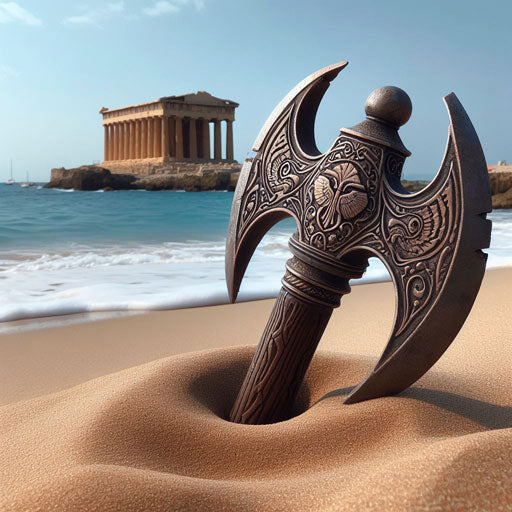Sections List:
- The Greek Name "Labrys"
- Etymological Analysis
- Cultural Significance
- Minoan Context
- Interpretation and Legacy
- Labrys Jewelry by Sirioti
- Conclusion
Introduction: In the vast tapestry of ancient civilizations, few symbols possess the mystique and cultural resonance of the Minoan double axe, known as the "Labrys." Delving into the etymology and cultural implications of its Greek name offers a rich tapestry of insight into its significance within Minoan society.

The Greek Name "Labrys": The term "Labrys" originates from ancient Greek, where it denotes a double-headed axe. Its linguistic roots intertwine with layers of cultural meaning, reflecting the deep symbolism associated with this iconic artifact. Linguists trace its origins to the Linear B script, an ancient form of writing used by the Mycenaean Greeks, which indicates its enduring presence in the Aegean world.
Etymological Analysis: The etymology of "Labrys" is a subject of scholarly debate, with several theories posited to explain its origins. Some suggest a connection to the Lydian word "labrys," meaning "double-edged," hinting at potential cultural exchanges between ancient Anatolia and the Aegean. Others propose links to the non-Greek languages of prehistoric Crete, pointing to possible indigenous roots of the term.
Cultural Significance: The adoption of the term "Labrys" by the ancient Greeks underscores the cultural assimilation and exchange prevalent in the Aegean Bronze Age. It signifies the cross-pollination of ideas, symbols, and technologies among diverse civilizations, including the Minoans, Mycenaeans, and Anatolians. As such, the Labrys embodies a convergence of cultural influences, reflecting the interconnectedness of ancient Mediterranean societies.
Minoan Context: Within the context of Minoan civilization, the Labrys assumes multifaceted significance. Beyond its utilitarian function, it serves as a potent symbol of power, fertility, and religious devotion. Its presence in Minoan art, architecture, and religious iconography underscores its central role in the spiritual and social fabric of society. The Labrys embodies the Minoans' reverence for nature, their complex religious beliefs, and their profound connection to the land and sea.
Interpretation and Legacy: Interpreting the significance of the Labrys within Minoan culture requires a nuanced understanding of its diverse contexts and associations. Its enduring legacy extends far beyond its archaeological remnants, permeating the realms of mythology, art, and collective memory. As we unravel the layers of meaning embedded within its Greek name, we gain deeper insights into the rich tapestry of Minoan civilization and its enduring impact on subsequent cultures.

Labrys Jewelry by Sirioti: For those fascinated by the allure of Minoan symbolism, Sirioti Jewelry offers a stunning collection inspired by the Labrys design. Crafted with exquisite attention to detail, each piece captures the essence of this ancient symbol, allowing wearers to carry a piece of Minoan history wherever they go. From intricately designed pendants to elegant earrings, the Sirioti Jewelry collection pays homage to the enduring legacy of the Labrys.
Conclusion: The Greek name "Labrys" serves as a linguistic portal to the rich tapestry of symbolism, culture, and history surrounding the Minoan double axe. Its etymology offers clues to the cross-cultural exchanges and influences that shaped the ancient Aegean world. By analyzing its significance within Minoan society, we gain a deeper appreciation for the multifaceted meanings encapsulated within this iconic artifact. As we continue to explore the enigmatic realm of Minoan civilization, the Labrys stands as a testament to its enduring legacy and the timeless allure of ancient symbolism.


1 commento
SO AMUSING!